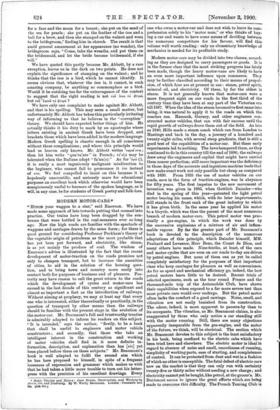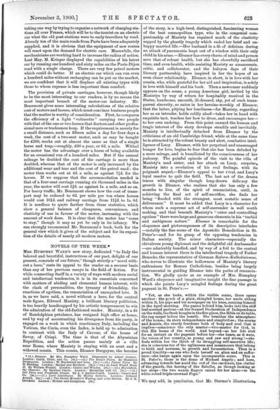MODERN MOTORCARS.*
" HITCH your waggon to a star," said Emerson. We have made some approach of late towards putting that counsel into practice. Our trains have long been dragged by the sun- beams that were bottled in the coal-measures ever so long ago. Now the high roads are familiar with the spectacle of waggons and carriages drawn by the same force ; for there is good ground for considering Professor Peckham's theory of the vegetable origin of petroleum as the most probable that has yet been put forward, and electricity, like steam, is as yet mainly the produce of coal. The wisdom of Emerson's advice is illustrated by the fact that the recent development of motor-traction on the roads promises not only to cheapen transport, but to increase the amenities of cities, to aid in the solution of the housing ques- tion, and to bring town and country more easily into contact both for purposes of business and of pleasure. Pos- terity may have reason to call the great return to the roads which the development of cycles and motor-cars has caused in the last decade of this century as significant and almost as important a fact as the introduction of railways. Without aiming at prophecy, we may at least say that every one who is interested, either theoretically or practically, in the question of transport by other means than the railways should be familiar with the present stage in the evolution of the motor-car. Mr. Beaumont's full and trustworthy treatise is admirably adapted to inform its readers on this subject. "It is intended," says the author, "firstly, to be a book that shall be useful to engineers and motor vehicle constructors ; and secondly, that those who take an intelligent interest in the construction and working of motor vehicles shall find in it more definite in- formation, description, and explanation than has [sic] yet been placed before them on these subjects." Mr. Beaumont's book is well adapted to fulfil the second aim which he has here proposed to himself, in spite of a frequent looseness of expression and grammar which makes us wish that he had taken a little more trouble to turn out his letter- press with the precision of his excellent drawings. Every • Motor Vehicles and Motors: their Design, Construction, and Working by 'Strum, OIL, and Electricity. By W. Worby Beaumont. London : Constable and CO. (428.net.1
one who owns a motor-car and does not wish to leave its corn.. prehension solely to his "motor man," or who thinks of buy. ing a car and wants to have some means of deciding between the numerous competitors for his favour, will find this volume well worth reading : only an elementary knowledge of mechanics is needed for its profitable study.
Modern motor-cars may be divided into two classes, accord. ing as they are designed to carry passengers or goods. It is in the former class that the most striking progress has lately been made, though the heavy motor-vans are likely to have an even more important influence upon commerce. They may be farther classified according to their means of propul- sion, of which four are at present in use : steam, petrol spirit, mineral oil, and electricity. Of these, by far the oldest is steam. It is not generally known that motor-cars were a more frequent sight on our roads in the first third of the century than they have been at any part of the Victorian era till 1897. When the idea of the steam locomotive first came into being, it was natural to apply it to the roads on which the coaches ran. Hancock, Gurney, and other engineers con- structed motor vehicles, that ran with fair success until the rapid growth of railways drove them out of the field. As late as 1840, Hills made a steam coach which ran from London to Hastings and back in the day, a journey of a hundred and twenty-eight miles, with several steep gradients, that is still a good test of the capabilities of a motor-car. But these early experiments led to nothing. The laws hampered them, as they continued to do in this country till the end of 1896; the railways drew away the engineers and capital that might have carried them nearer perfection; still more important was the deficiency in those days of the accurate and ingenious machine tools that now make exact work not only possible but cheap as compared with 1830. From 1835 the use of motor vehicles on our roads, save in the form of traction-engines, was in abeyance for fifty years. The first impetus to the new movement of invention was given in 1885, when Gottlieb Daimler—who died in the spring of this year—patented the light petrol motor bearing his name, which, with its later improvements, still stands in the front rank of the great industry to which it has given birth. In the same year he applied his motor to a bicycle, which was thus the parent of the most numerous branch of modern motor-cars. This petrol motor was prac- tically a gas-engine, in which the work was done by the successive explosions of a mixture of air and inflam- mable vapour. By far the greater part of Mr. Beaumont's book is devoted to the description of the numerous adaptations of this principle, which Daimler himself, MM. Panhard and Levassor, Herr Benz, the Count de Dion, and many others have made. Nine-tenths, at least, of the cars and motor-cycles that are seen on our roads to-day are driven by petrol engines. But none of them can as yet be called completely satisfactory for the purposes of that important class who keep carriages for pleasure as well as convenience. As far as speed and mechanical efficiency go, indeed, the best petrol motors leave little to be desired. Recent trials of selected specimens, such as the tour round France and the thousand-mile trip of the Automobile Club, have shown their capabilities when exposed to a far more severe test than most private cars would ever undergo. But the petrol motor often lacks the comfort of a good carriage. Noise, smell, and vibration are not easily banished from its construction. The odour, indeed, is more apparent to passers-by than to its occupants. The vibration, as Mr. Beaumont claims, is also exaggerated by those who only notice a car standing still with the motor running. Still, there are many objections apparently inseparable from the gas-engine, and the motor of the future, we think, will be electrical. The section which Mr. Beaumont devotes to this subject is the least satisfactory in his book, being confined to the electric cabs which have been tried here and elsewhere. The electric motor is ideal in regard to absence of noise and smell, smoothness of running, simplicity of working parts, ease of starting, and completeness of controL It can be protected from dust and wet in a fashion of which no other is susceptible. The fatal defect of electric cars now on the market is that they can only run with certainty twenty-five or thirty miles without needing a new charge; and electricity cannot yet be bought, like petrol, at the grocer's. Mr. Beaumont seems to ignore the great efforts which are being made to overcome this difficulty. The French Touring Club is
taking one way by trying to organise a network of charging sta- tions all over France, which will be to the tourist on an electric ear what the old post-stations were to early travellers by road. Already ten of the main roads from Paris have been adequately supplied, and it is obvious that the equipment of new routes will react upon the demand for electric cars. Meanwhile, the mechanicians are working hard to increase the radius of action. Last May, M. Krieger displayed the capabilities of his latest car by running one hundred and sixty miles on the Paris-Dijon road with a single charge. There are very few petrol motors which could do better. If an electric car which can run even a hundred miles without recharging can be put on the market, we are confident that it will displace all existing types with those to whom expense is less important than comfort.
The provision of private carriages, however, though likely to be the most interesting to our readers, is by no means the most important branch of the motor-car industry. Mr. Beaumont gives some interesting calculations of the relative cost of motors and horses, which must convince business people that the matter is worthy of consideration. First, he compares the efficiency of a light " voiturette " carrying two people with that of the one or two horses that doctors and other profes- sional men or tradesmen keep. If the requirement is merely for a small distance, such as fifteen miles a day for four days a week, the cost of a two-seat motor, such as may be bought for 2200, works out at almost the same as that of a single horse and trap,—roughly, 280 a year, or 6d. a mile. Withal the motor has the advantage over a horse of being available for an occasional run of a hundred miles. But if the annual mileage be doubled the cost of the carriage is more than doubled, whereas that of the motor is only increased by the additional wear and tear and the cost of the petrol used : the motor then works out at 4d. a mile, as against 7id. for the horses. If we suppose that the accommodation needed is that of a four-seat carriage running six thousand miles in the year, the motor will cost 5id. as against is. a mile, and so on. For heavy traffic, Mr. Beaumont shows how the cost of trans- port may be reduced to 6d. per mile per ton where horses would cost Did, and railway carriage from llfd. to is. 8d. It is needless to quote farther from these statistics, which show a general balance of cheapness, convenience, and elasticity of use in favour of the motor, increasing with the amount of work done. It is clear that the motor has "come to stay," though it may as yet be only in its infancy. We can strongly recommend Mr. Beaumont's book, both for the general view which it gives of the subject and for its exposi- tion of the details of nearly all modern motors.























































 Previous page
Previous page